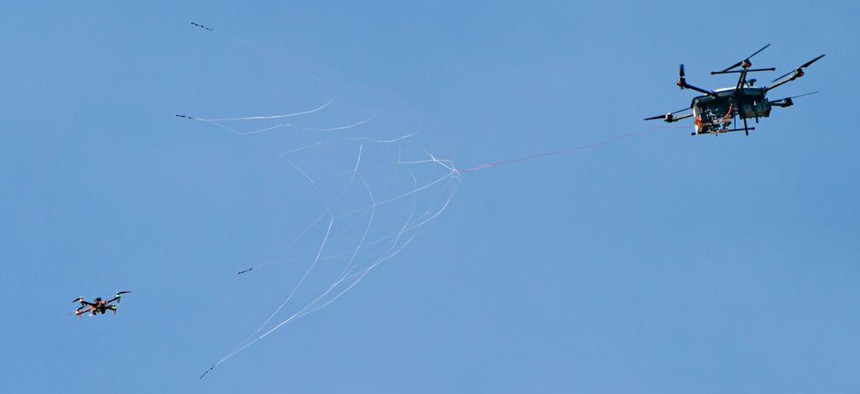
A DroneHunter F700 fires its net at a target drone in a demonstration. Fortem Technologies
A drone-maker’s dilemma illustrates Ukraine’s struggle to get key arms
Fortem could feed Kyiv’s hunger for anti-drone defenses—if it could find funding for a second production line, the company says.
As Ukraine hunts for more anti-drone gear, at least one U.S. manufacturer is poised to help—and cash in—if it can find the funding to open a second production line.
Fortem Technologies’ dilemma offers a glimpse into the opportunities and problems of defense suppliers to Ukraine. The company is seeking several million dollars to fund a new line, CEO Jon Gruen said in a recent interview.
If the funding comes through in a timely fashion, the company can start delivering the drones by early 2024, Gruen said. Fortem, founded in 2016 in Utah, builds its drones mostly with commercially available components, which reduces production hang-ups, he said.
Fortem’s drones fire nets to entangle enemy drones, an approach that seeks to minimize damage to nearby infrastructure. The product rose to prominence after taking out Iranian Shahed-136 loitering munitions, which Russia used to cause electricity blackouts in Ukraine last year.
In January, the Ukrainian government crowd-funded the purchase of six of Fortem’s DroneHunter F700 drones, and deployed them near power plants.
Ukraine expects the recent uptick in Russian drone attacks to last into the winter, thanks in part to Moscow’s push to manufacture Shahed-136s and other long-range attack drones.
In a November essay published by the Economist, Ukrainian Commander-in-Chief Valerii Zaluzhnyi seemed to signal out Fortem’s tools for praise, listing “hunter drones with trap nets on board,” as number two on his priority list for gaining air superiority.
Fortem, which initially sold to Ukraine’s Ministry for Digital Transformation, now sells directly to three Ukrainian ministries, Gruen said. Ukraine buys the drones from Fortem, rather than receiving them in foreign aid packages.
Gruen said battlefield use has helped improve his company’s products.
One of the key modifications was improving the drones’ resistance to Russian electronic warfare, which Ukrainian drone commanders cite as a major problem. Fortem also had to adapt its drones so that it could take out Shahed-136s, which weigh over 400 pounds.
In some cases, Gruen said, Fortem experts know more about Russian threats than their Defense Department contacts.
British Armed Forces Minister James Heappey has said that Western defense companies working in Ukraine “were accessing the latest information on Russian [electronic warfare] capabilities.”
Fortem’s drones have also drawn U.S. government interest, particularly among the combatant commands in charge of day-to-day operations abroad, Gruen said.
Despite the high interest, however, funding the drones is another matter. Ukraine is facing vast budget deficits, with 2024 set to see a budget shortfall of $43.58 billion.
Foreign sources for funding, meanwhile, come with complications. U.S. weapons to Ukraine must be first cleared and may go through a contracting process lasting as much as a year to deliver.
European funding, meanwhile, can come with fewer strings but less money. The British-led International Fund for Ukraine skips standard procurement procedures, and has helped field new anti-drone technologies to Ukraine.
The fund is backed with around $1 billion, far less than the U.S.’s prime funding stream for buying new weapons for Ukraine, the Ukraine Security Assistance Initiative (USAI). USAI has $18.6 billion in funds, with around $9.9 billion committed at a rate of around $1.2 billion per month since July.




